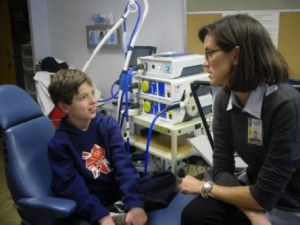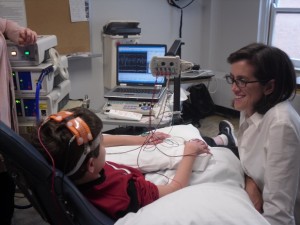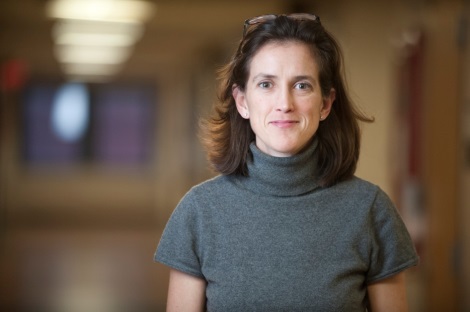“Research” What You Say: I Did Not Suffer a Stroke, I Survived One
Table of Contents
Study Flyer: “Pediatric Hemiparesis: Synergistic Treatment using Non-Invasive Brain Stimulation and Constraint-Induced Therapy. Join a collaborative pediatric research study in congenital hemiparesis. The purpose of this study is to determine whether non-invasive transcranial magnetic brain stimulation (TMS) combined with constraint-induced movement therapy (CIMT) results in improved hand control and brain activity.”
I am 18 years old. I had a stroke at 26 weeks gestation when my mother was pregnant with me. I have therefore had ‘hemiparesis’—which means I’ve been weaker on one side of my body—for 18+ years. A researcher from the University of Minnesota has just sent me a flyer about potential participation in a study. My initial reaction was confusion. I had no idea why someone wanted me to participate in a study. I was pretty hesitant to say “yes” to such an endeavor I did not know a lot about. Then I started to wonder how in the world did someone find out about me? I could not wrap my head around the fact that someone sought me out. I showed the flyer to my parents and asked, “What am I supposed to do with this? How did this researcher find me?”
I have never known what it is like to grow up or live life where everything functions “normally” or know what that even means.1 I know what ‘congenital hemiparesis’ means, and after years and years of therapy I know that I am my own ‘normal’.2 So when a researcher is recruiting me for a study which aims to “improve function in children with congenital hemiparesis” I asked, ‘What do you mean by improve my function’? Is there something that needs improving about me or aren’t I already doing well in this body that has served me my whole life? I didn’t ‘suffer’ a stroke, I survived it. I even thrive!’
Once I read through the flyer with both my parents, the idea of being put through any sort of brain stimulation also scared me. I was very hesitant to say yes. During my annual check-up at the Children’s Hospital, I discussed the idea of taking part in the study with my doctor. “Do you know anything about this researcher and her laboratory? Do you think it would be a good idea for me to do the research?” My doctor said that she knew the researcher and understood the design of the study. She explained that the study had just started and that she had been the one to recommend me to this research team. Hearing all this made me feel at ease. If my orthopedic surgeon trusted the researcher then, I decided, so should I. A few weeks later, I gathered all my medical documentation, contacted the lab and prepared myself mentally to take part in research that could have the potential to change the lives of many. My expectations were to participate to see if anything about my function would be different, or if participating would help other people like me.
 But I didn’t want them to go on using ‘improve’ as I didn’t think they understood what that means to a young person who has dealt with a stroke her whole life. ‘Improve’ means to me that I am not currently functioning at my full potential, or ‘giving it all I’ve got’. I have grown up knowing that I can accomplish anything I set my mind to, although the frustration of having to take a lot longer than a “normal” person always lingers in my mind. Having hemiparesis makes grasping any sort of small object one of the biggest daily challenges I face. The simplest of tasks becomes one of the hardest obstacles I have to overcome. When I arrived, I explained my thoughts to Dr. Gillick about participating and gave her feedback on how to word their future recruitment flyers.3,4
But I didn’t want them to go on using ‘improve’ as I didn’t think they understood what that means to a young person who has dealt with a stroke her whole life. ‘Improve’ means to me that I am not currently functioning at my full potential, or ‘giving it all I’ve got’. I have grown up knowing that I can accomplish anything I set my mind to, although the frustration of having to take a lot longer than a “normal” person always lingers in my mind. Having hemiparesis makes grasping any sort of small object one of the biggest daily challenges I face. The simplest of tasks becomes one of the hardest obstacles I have to overcome. When I arrived, I explained my thoughts to Dr. Gillick about participating and gave her feedback on how to word their future recruitment flyers.3,4
Revised Study Flyer: “Now Recruiting, ‘Combined Intervention for Hand Function’. Does brain stimulation and intensive therapy improve change movement of the hand? We are currently studying a form of non-invasive brain stimulation with constraint-induced hand rehabilitation to investigate the influence on improving hand function.” [sic]
 So, there was one thing that caught my attention about participating in this study. It seems the researchers were telling me that I shouldn’t be satisfied, that I could still do more to influence my ‘recovery’. Perhaps this is true, but shouldn’t it be me educating them, the researchers, as to what my goals are and whether or not they pertain to changing or recovering the function of my hand? And how do I ‘recover’ when I have been weak on one side of my body since birth? As I entered the lab and thought about all of this, I became overwhelmed and hesitant to actually take part in this research. Yet I was already there and I did not want to back out of an obligation that I knew could potentially change the lives of many. And being part of a research study brought all those thoughts back up again and again. So I tried, as best I could, to complete the assessments and interventions, to see if anything about my function would change.
So, there was one thing that caught my attention about participating in this study. It seems the researchers were telling me that I shouldn’t be satisfied, that I could still do more to influence my ‘recovery’. Perhaps this is true, but shouldn’t it be me educating them, the researchers, as to what my goals are and whether or not they pertain to changing or recovering the function of my hand? And how do I ‘recover’ when I have been weak on one side of my body since birth? As I entered the lab and thought about all of this, I became overwhelmed and hesitant to actually take part in this research. Yet I was already there and I did not want to back out of an obligation that I knew could potentially change the lives of many. And being part of a research study brought all those thoughts back up again and again. So I tried, as best I could, to complete the assessments and interventions, to see if anything about my function would change.
Final Revised Study Flyer: “Research Opportunity: Actively recruiting for a study involving children and young adults ages 8-21 with hemiparesis combining rehabilitation and brain stimulation. The majority of older children and young adults who have had a stroke since birth and who have participated in our studies reported that they were no longer actively receiving therapies. However, 100% had further hand goals they wanted to achieve, especially considering their upcoming transition to adolescence and adulthood.”
 Each day I hope to change my hand function, but I think it’s up to me to determine if we call that ‘improving’ function or not. As the research study came to a close, I shared these final remarks with the researcher and her staff: “I did not participate in this study so that I might benefit from it; I am doing it for future children who have strokes. That they might have the chance to change and benefit from something I myself directly may not. I am doing it for all of them.” As I completed the study, the researcher turned to me and said “You have changed my view and have educated me more than I could have ever educated you. Thank you!”
Each day I hope to change my hand function, but I think it’s up to me to determine if we call that ‘improving’ function or not. As the research study came to a close, I shared these final remarks with the researcher and her staff: “I did not participate in this study so that I might benefit from it; I am doing it for future children who have strokes. That they might have the chance to change and benefit from something I myself directly may not. I am doing it for all of them.” As I completed the study, the researcher turned to me and said “You have changed my view and have educated me more than I could have ever educated you. Thank you!”
As a person living with a stroke her whole life, I have been grateful for the guidance I have received from therapists and researchers. But remember, please don’t think that my function is something you need to improve. I did not suffer a stroke, I survived one. And I am ‘normal’ because this is who I am and who I have always been.
Yet I will always have goals and the potential to change. Just like you.
References
1. Couser GT. What disability studies has to offer medical education. Journal of Medical Humanities. 2011;32(1):21-30. doi: 10.1007/s10912-010-9125-1.
2. Jalayondeja C, Jalayondeja W, Suttiwong J, Sullivan PE, Nilanthi DLHK. Physical activity, self-esteem, and quality of life among people with physical disabilty. Southeast Asian J Trop Med Public Health. 2016;47(3):546-558.
3. Rosenthal MS, Connor KA, Fenick AM. Pediatric residents’ perspective on family-clinician discordance in primary care: a qualitative study. J Health Care Poor Underserved. 2016;27(3):1033-1045. doi: 10.1353/hpu.2016.0114.
4. Kratovil AL, Julion WA. Health-care provider communication with expectant parents during a prenatal diagnosis: an integrative review. J Perinatol. 2016. doi: 10.1038/jp.2016.123.
About the Author(s)

Bernadette Gillick, PhD, MSPT, PT
Bernadette Gillick, PhD, MSPT, PT received her BS in Physical Therapy from Marquette University in 1993, her advanced masters in Neurologic PT from Rosalind Franklin School of Medicine in 1998 and completed her PhD in Rehabilitation Science with a minor in Neuroscience at the University of Minnesota in 2011. She is now a funded tenure-track Assistant Professor in the Physical Therapy Program within the University of Minnesota Medical School, and Co-Director of the Brain Plasticity Laboratory. Her lab investigates neurodevelopment after pediatric stroke through neuroimaging, neuromodulation and rehabilitation. As a lifelong learner, Dr. Gillick highly values feedback from both the children and caregivers involved in her studies. Her studies are built not only on the quantitative outcomes, but also on data amassed from family focus polls, participant feedback and tolerance assessments.

This work is licensed under a Creative Commons Attribution 4.0 International License.

